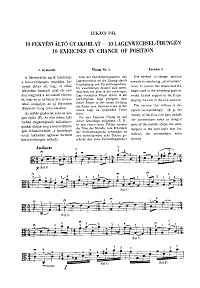Lukach - Finger position exercises for viola
Lukach - Finger position exercises for viola. You can download the PDF sheet music Lukach - Finger position exercises for viola on this page. These exercises are intended for enhancing the technic quality of violist's left hand, especially paying attention to the technique of changing positions. Also paid attention to fingering, the problem, that often escaping from a field of view of viola players. At first, you can find 10 big exercises. Each from these exercices poses a particular problem and shows its solution, often unconventional. This book made very well and will bring you favor. To view the first page of Lukach - Finger position exercises for viola click the music sheet image.
|
| PDF format sheet music |
|
|
|
Viola part: 39 pages. 710 K
|
Piano part: Missed
|
 |
 |
| +++ |
|
| Download PDF (14.99
€) |
|
Exercise 1.
One method to change position consists in employing „intermediate" notes. In essence this means that the finger used in the preceding position would furnish support to the finger playing the note in the new position.
The exercise that follows is designed correspondingly. (E. g. the melody of the first nine bars include the intermediary notes as integral parts of the melodic shape; the same happens in the next eight bars but without the intermediary notes shown.)
Exercise 2.
In addition to training of broken triads with the familiar fingering, this scale exercise aims at achieving security in the kind of position change which involves the so-called stretched fingering. The purpose of this method is to eliminate the necessity of skipping from one position to the other.
It may greatly help to obtain that musical considerations should determine and guide the mode of connecting, tones.
This exercise is designed to demonstrate the various cases in which such changes of position, viz. whether the already familiar broken triads, or stretched fingering, or fingering combined with open strings respectively should be performed and applied.
Exercise 3.
This exercise includes an additional case requiring change of position. Besides the method of stretched fingering and the aid of open string, it provides for the training of changes executed with the same finger in case of a semitone distance. Its second part furnishes material for the training of connecting notes by unsupported skips at greater intervals.
Exercise 4.
In addition to all the various kinds of changes discussed hitherto, this exercise demonstrates the supremely important case of octaves achieved by fifth stopping. Essentially this refers to performing perfect octaves by placing the same finger on the fifth of the initial note and producing a fourth over the fifth by means of the method already acquired at practicing, the basic positions. This exercise should also be practiced with détaché and jeté bowings.
Exercise 5.
This exercise consists of two parts. The first aims at acquiring perfection in performing thirds. The second is much more demanding in respect of clearness in both harmony and technique. The harmonies that change with each triplet are thus retaining the student's attention and contributing to the development of his aural imagination and alertness.
Additional problems to be solved are the performance of tenths and octave passages obtained by skips. The entire exercise is to be played with jete bowing.
Exercise 6.
The first part of this exercise is designed as a further drill of passages involving thirds and tenths. The second part aims at practicing changes of position at a more distant interval, partly with the help of stretched fingering and partly by involving open strings, according to already familiar schemes. A new aspect is here the practicing of position change without any support.
The quavers are to be executed with jeté bowing, whilst the semiquavers and the second part involving sextuplets with détaché.
Exercise 7.
This exercise summarizes the various changes of position encountered so far. The only novelty consists of the sixteen-bars long middle section with its successions of simple thirds and sixths, and the fairly simple problems that are associated with it.
Exercise 8.
This etude is again designed to familiarize the changes of position discussed so far, in association with varying and unusual rhythmic patterns.
Exercise 9.
The first part of this so-called ,,one string" exercise presents an opportunity to practice a great variety of position changes, I would call the student's particular attention to the portamento changes executed with the same finger as shown in the second eight-bar group. The second part of the exercise is designed to training broken triads on one string.
Exercise 10.
The purpose of this etude is to make the student practice plain and chromatic scales on one string.
Eludes by Antal Ribáry, Endre Szervánszkv, and Jànos Viski are found in the subsequent section. The basic principles introduced in the exercises are incorporated here in free compositions. In these pieces fingerings are indicated only at places where they are fell to be indispensable; in order that the ability to devise his own fingering should be developed, the student is requested to provide all others on the basis of the ten preceding etudes.
|
|